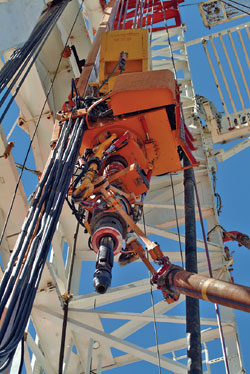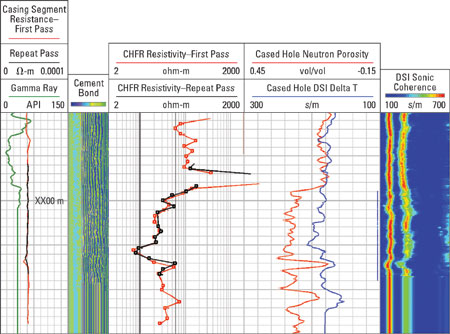Casing While Drilling
Key issues and technologies for the rapidly evolving casing while drilling technique
From rig design to downhole tools, new solutions are allowing quick adoption of this emerging technology across an expanding application and geographic base
Alexandra Pruner, Gulf Publishing Co., Houston
Although it's been nearly 40 years in the making, the casing while drilling technique seems to be entering a new phase, transforming from a thin niche to a larger slice of the drilling market, as fit-for-purpose tools become available and ideas for more applications build on earlier successes. The growing acceptance of Casing While Drilling (CWD) has spawned commercialization of related technologies to address issues ranging from casing running to new connections to formation evaluation. This has resulted in specialized rig designs, pipe-handling systems, logging and downhole tools, and software. Applications include extending casing points, drilling with surface conductor and underbalanced drilling – on both land and offshore – to name just a few.
FIT FOR PURPOSE RIGS
Lowering drilling costs – especially in marginal wells/ fields – is a prime reason for using the CWD technique. Improved safety is another. Wells in some South Texas locations are being casing drilled with only three strings of casing that previously required four strings when conventionally drilled. Activities are under way to demonstrate that combining underbalanced drilling techniques with CWD can further reduce drilling costs.
Tesco, which has been a pioneer in the technique, continues to provide three purpose-built CWD rigs in South Texas. Two are operating for ConocoPhillips, where more than 75 wells have been casing drilled with Tesco's system. These wells show the advantages of the casing while drilling process in reducing lost circulation, stuck pipe and well-control incidents in areas prone to having these problems.
The third CWD rig is working for Apache in an area where low reservoir pressure results in non-economic production rates with conventionally drilled wells. Three wells were casing drilled in this area in the third quarter of 2003, demonstrating an ability to reduce fluid losses to low-pressure payzones, which resulted in production rates that exceeded expectations. This performance stimulated a multi-well CWD program that commenced in January 2004.
The capability to directional drill with CWD was demonstrated when three directional wells were drilled in Mexico and one in Brazil during the last quarter of 2003. These wells included directional sections drilled with 9 5/8-in. and 7-in. casing at inclinations up to 40°. A test well was also drilled with 13 3/8-in. casing to demonstrate the ability to build, hold and drop inclination at desired rates while maintaining the desired azimuth heading.
NEW CASING RUNNING SYSTEM
Tesco initiated a commercial casing running service that uses casing handling tools developed for CWD. This service provides a more efficient and safer casing-running process when used with a top drive by reducing floor activity and the need for a stabber to work in the derrick. Casing tongs and elevators are eliminated, as well as any need to work off scaffolding on the floor. The casing running system offers the ability to rotate and circulate each joint of casing as it is run. This system has been used to run over 800,000 ft of casing on 113 jobs in sizes ranging from 4 1/2-in. to 13 3/8-in., Fig. 1.
 |
Fig. 1. Casing Drive Assembly by Tesco, shown configured with internal torque/ trip grapples and a ECI900 top drive system; replaces conventional power tongs, spider/ elevator, fill-up and circulating tool to improve safety and efficiency of casing running.
|
|
FORMATION EVALUATION
Adequate formation evaluation is accomplished with through-casing evaluation tools. Although such tools have been available as cased hole services for many years, recent advances in through-casing logging from all of the major service companies have mitigated this as an issue to a large extent. A good example is Schlumberger's Analysis Behind Casing suite (ABC). These logging tools incorporate electrical, nuclear, acoustic and formation sampling tools and methods, Fig. 2.
 |
Fig. 2. Through-casing evaluation of primary objective, Caroline field, Canada. CHFR resistivities (Track 3), combined with porosity measurements from sonic and neutron tools (Track 4), indicated high water saturation in the primary, deep objective near XX00 m. Gas was not indicated by neutron/ sonic tools, so, the zone was abandoned.
|
|
ABC resistivity can measure previously undetectable nanoampere fluctuations. Included in this cased-hole services suite are: integrated components of formation evaluation; deep-reading resistivity; a porosity tool that operates without a chemical source; a custom density tool; a shear sonic imager that helps evaluate wellbore stability, aids in hydraulic fracture-height prediction, and is useful in sanding analysis; and a tester tool for measuring multiple pressures and collecting fluid samples behind casing and plugging the hole to maintain casing integrity.
GROWING GEOGRAPHIC ACCEPTANCE
Drilling with conductor and surface casings in soft formation is gaining wider acceptance and receiving larger geographic coverage, as evidenced by Weatherford International's work with 32 operators in 16 countries. The process is safe, simple and has been economically applied to land, platform, jackup and seimisubmersible operations. Savings for semisubmersible operations have averaged $300,000 – $400,000 compared to historical data.
The system for drilling with surface casing includes a disposable/ drillable drill bit, float equipment, centralizers as required, and a connector from the top drive to the casing. Technology advancements are expanding the operational envelope, allowing longer intervals and harder formations to be effectively drilled.
The largest growth segment of the market is drilling with liners, which allows operators to overcome a variety of drilling problems. These problems include lost circulation zones, drilling into transition zones, drilling through mobile formations, drilling through isolation plugs, and reaming liners to bottom through excessive fill or unstable hole conditions.
The key elements of a drilling liner are hangers and running tools that will not prematurely set or release while withstanding drilling torques. The small annular clearance between the liner hanger, liner top packer and PBR is what limits the liner-drilling assembly's ability to drill complete intervals in many wells. However, the technology is being used effectively to drill and set the liner through problem zones.
Moving forward, developments are underway to address the annular clearance issues and further advance the application of this technology. There are no special drilling rig requirements when drilling with liners – drill pipe is in the rotary and drilling proceeds much like with a conventional BHA. This technology has been applied in land operations in the US, Australia and various basins in Asia, as well as in water depths greater than 4,500 ft in both the North Sea and GOM.
GrantPrideco is testing an 11 3/4-in. connection, the DWC/DS-A, which is an integral design that is on heavy walled casing and incorporates a double shoulder. It is designed for a liner that is drilled in, and exposed to, significant differential pressures, for use by an operator in the GOM in 2004. Testing of the DS-A verified the thread pressure sealing capability, including internal pressure with tension, as well as collapse pressure. Torsional strength rating and resistance to galling was successful, testing at 80,000 ft-lb of torque.
COMBINING CWD, UBD AND MANAGED PRESSURE
During recent attempts to lower drilling costs in several South Texas fields, an unlikely yet surprisingly practical blend of several oilfield technologies has been developed that may set a substantial, cost-effective trend in the evolution of drilling techniques. The process involves a combination of UnderBalanced Drilling (UBD) and CWD, while simultaneously using Managed Pressure (MP) to widen the window of pore-pressure ranges that can be addressed in openhole, while isolating pressures and rendering them harmless to the formation's integrity.
The inventive method, dubbed UBCD-MP, has the potential to eliminate the need for one or more intermediate casing strings. This major sidestep in the drilling process could dramatically reduce cost. The process also has the potential to cut a sizeable amount of drilling costs in “small opportunity” wells where production is uneconomic, as well as larger production areas where additional cost-effective measures would simply add to the bottom line.
A robust hydraulic model is required for the UBCD-MP process. The technique can be hazardous without a complete understanding of the formation. By using the Hydraulic UnderBalanced Simulator (HUBS) – a computer software developed by Signa Engineering that is based on actual field results – economic benefits may be realized by using the unique UBCD-MP technology blend.
The program diagrams exact pressure profiles within an extended vertical section of hole and shows how a planned well can be drilled with pre-determined mudweights to preserve the integrity of the low and high-pressure zones. As an example in planning a certain well, the high-pressured zones in question are kept isolated despite the fact that the lower 5,000 ft of wellbore penetrates extremely contrasted formation pressures without an intermediate casing string. The well completion can be done by setting a 7 1/2-in. casing inside an 8 in. cased hole at 10,000 ft, and the casing run to a primary target of 15,000 ft.
Conventional overbalanced drilling limits the window of pressure management. Weak rock or a pressure-depleted zone can complicate the driller's ability to achieve the next casing seat. The UBCD-MP technology blend can increase the window of pressure management in such cases, which could make the difference in attaining TD in a deep well or finishing a well with three casing strings instead of four. 
|




